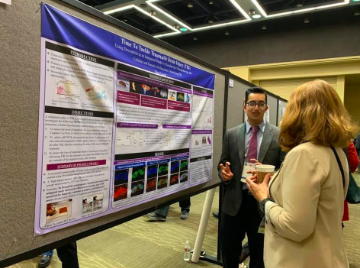JUMPing into the future of Traumatic brain injury treatment
Junior Shan Lateef recognized as a delegate of the American Junior Academy of Science

Junior Shan Lateef presents his groundbreaking research on traumatic brain injury to a judge at the 2019 Virginia Academy of Science symposium.
March 4, 2020
Jefferson junior Shan Lateef traveled to Seattle, Wash. for the annual National American Junior Academy of Science (AJAS) conference on Feb. 12, 2020. This organization is America’s only national honor society for high school scientists. After placing first at Virginia’s Academy of Science research competition in May 2019, Lateef was invited to present his work to peers and scientists as well as be inducted as a lifelong Fellow of the AJAS. The four-day conference was held in conjunction with the annual meeting of the American Association for the Advancement of Science (AAAS), the largest scientific organization in the world and publisher of the academic journal “Science.”
“Jefferson has competed in the past but not that many students actually compete because it’s kind of hard to write a long paper in addition to doing a lot of other competitions,” Lateef said. “After they read your paper and you get accepted to [Virginia’s Academy of Science symposium], you attend and you get to listen to a lot of different kinds of interesting lectures at the college university that they host.”
This past year, the state symposium was held at Longwood University. The participants were first categorized based on the topic of their research. Within their category, the student presented their work to four judges, slideshow-style, and the public. Lateef placed first in his category of which composed of 20 to 30 students. He was then judged against each category’s first-place winner and chosen as the first of the top four research papers. The Academy invited these four student researchers to attend the AJAS conference in Seattle.
“[The conference was] really cool because you got to see Microsoft and a lot of new museums,” Lateef said. “[Students were allowed to present as] either part of a research roundtable or the traditional PowerPoint style. I chose the research roundtable just because I like talking more about what I like to do outside of research.”
While the fellowship selection process is competitive, Lateef saw the entire process more as a way to talk and learn about innovations in science.
“There’s not really an award but the really cool part is that you get inducted as a lifetime fellow to AJAS and you get to go back every year and present,” Lateef said. “We got to socialize with a lot of other students who are from different state academies, conducted different kinds of research, and have all different kinds of mentors. The best part is that the national conference isn’t a competition so you’re not worried about winning or losing. Just getting that recognition for my research meant a lot to me.”
The journey Lateef took to conduct his groundbreaking research began in the eighth grade. He studied the effects of UV radiation and antioxidant nutrition on Drosophila melanogaster, or fruit flies. After realizing its potential as a model organism, Lateef decided to continue his research in high school.
“When I came to TJ, I realized the JUMP lab has a lot of neat opportunities that I could utilize,” Lateef said. “I was researching different types of neurodegenerative diseases because I’m interested in neuroscience. I read a New York Times article about the growing epidemic of traumatic brain injury (TBI) and looked at how people treat concussions or how doctors usually deal with TBI. I realized there is really no effective treatment strategy we have out there unlike a lot of other diseases like Parkinson’s and Alzheimer’s.”
The Jefferson Underclassmen Multidisciplinary Project (JUMP) lab, is a unique research opportunity for underclassmen at Jefferson. Students in grades 9 through 11 can submit a research proposal to the sponsor, Dr. Jennifer James, in groups of up to three. If accepted, these students are then given the necessary funds and equipment to complete their experiment and their research project is submitted to the annual science fair.
“Lateef was unique in that he had a clear research idea and protocols to implement it,” James said. “Most freshmen don’t know enough about the JUMP lab to take advantage of it, so I was impressed with Lateef’s thorough research plan.”
Lateef’s research investigates therapeutic hypothermia as a potential intervention treatment for TBI and discovered that it significantly mitigated some of the deleterious effects. These results were published in the Journal of Experimental Neuroscience. Throughout his high school career, Lateef was supported by the JUMP lab.
“The JUMP lab is really an environment for budding scientists who want to do research,” Lateef said. “If you know what you want to do you can really accomplish almost anything, as [the guidance and money] has really been beneficial. Dr. James especially helped when it came to writing my paper for publication..”
Future directions for Lateef include optimizing hypothermia as a treatment strategy now that he has established an extensive array of TBI effects. Over the past three years, Dr. James and Lateef have learned from each other as both mentor and student.
“I was interested in the topic because it is similar to the neurovascular research that I did as a graduate student and postdoc,” James said. “While I studied embryonic development in avian and mouse embryos, Lateef was studying this new Drosophila system and learned how to dissect and immunostain their brains [from other experts]. He came back and showed me how to do that. So I’m learning from him, and he’s learning some things from me, and it really makes me think about what a great scientific community we have here and how we’re bringing other institutions into our work.”





